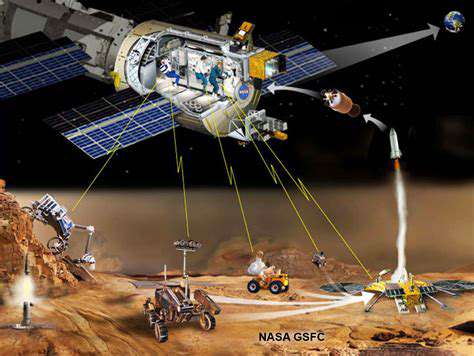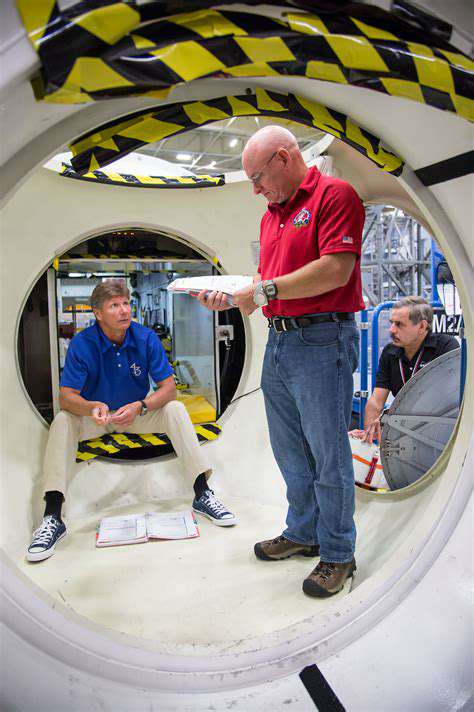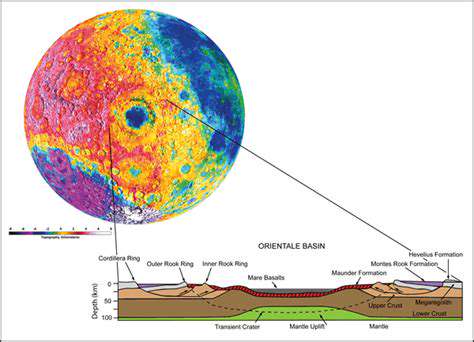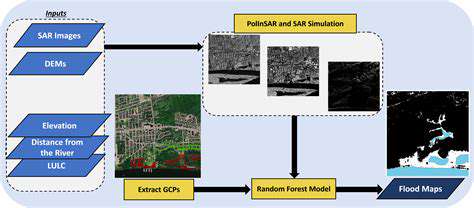The development of Advanced Air Mobility (AAM) hinges critically on the creation of a robust and interconnected ground infrastructure. This infrastructure isn't just about airports; it encompasses a complex network of charging stations, maintenance facilities, and potentially even specialized vertiports designed to accommodate the unique needs of electric vertical takeoff and landing (eVTOL) aircraft. Without this supporting network, the promise of AAM remains largely unrealized, as aircraft require reliable and efficient ground support to operate effectively.
Careful planning and investment in ground infrastructure are essential to address the unique challenges posed by AAM. This includes considering factors such as power grids, communication networks, and safety protocols, ensuring the seamless transition between ground and air operations. The scale and complexity of this infrastructure are considerable, demanding extensive collaboration between government agencies, private companies, and researchers to ensure its effectiveness.
Vertiports: A New Paradigm in Urban Air Mobility
Vertiports, designed specifically for vertical takeoff and landing aircraft, represent a revolutionary approach to urban air travel. These strategically located hubs will serve as crucial access points for AAM services, providing safe and efficient takeoff and landing areas for passengers and cargo. The design of vertiports will need to consider factors such as noise reduction, airspace management, and integration with existing urban environments. The development of these facilities will be crucial to the widespread adoption of AAM and its integration into existing transportation networks.
Beyond simple landing pads, future vertiports may incorporate advanced features like charging stations, maintenance bays, and even passenger terminals for a seamless user experience. Imaginative urban planning that incorporates vertiports into the fabric of cities will be essential to realize the full potential of AAM in transforming urban mobility.
Maintenance and Repair Facilities: Ensuring Reliability and Safety
The reliability and safety of AAM systems depend heavily on readily available and efficient maintenance and repair facilities. These facilities will be critical for ensuring the continued operational readiness of the fleet, preventing delays, and maintaining the safety record of these innovative aircraft. The complex nature of eVTOL aircraft necessitates specialized maintenance personnel, tools, and techniques, demanding significant investment in training and infrastructure.
Maintaining a robust network of maintenance hubs is critical for supporting the growing AAM fleet. These facilities will need to be strategically located to minimize downtime and ensure rapid response times for repairs and maintenance. This infrastructure will play a vital role in preventing accidents, ensuring the long-term safety and success of AAM.
Charging Infrastructure: Powering the Future of Flight
Electric vertical takeoff and landing (eVTOL) aircraft rely heavily on readily available and efficient charging infrastructure. The development of this infrastructure is critical to the widespread adoption of AAM. Rapid charging stations will need to be strategically located throughout the network, providing reliable power sources for eVTOL aircraft. The high energy density required by these vehicles will necessitate significant investment and innovative solutions to meet the demands of the future air mobility market.
The integration of charging infrastructure into the existing power grid will be a significant undertaking. This will require careful planning to ensure efficient energy distribution and minimize the impact on existing power systems. The widespread implementation of charging infrastructure across various locations, from urban hubs to remote areas, is vital to unlock the full potential of AAM.
Passenger Terminals and Integration with Existing Infrastructure
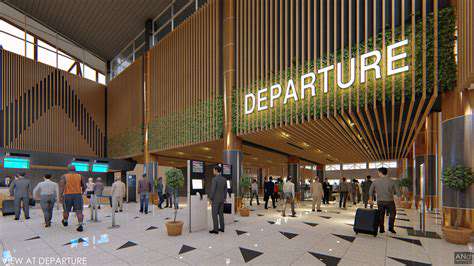
Passenger Terminal Design Considerations
Modern passenger terminals must prioritize efficiency and passenger experience. Careful consideration of layout, flow, and accessibility is crucial for minimizing wait times and maximizing comfort. This includes strategically placing baggage claim areas, security checkpoints, and gate entrances to streamline the passenger journey. Thoughtful design should also incorporate ample space for queuing, comfortable seating, and clear wayfinding signage, ensuring a smooth and positive experience for all travelers.
Furthermore, terminals must be designed with future growth in mind. Adaptability to potential increases in passenger volume and evolving transportation needs is essential. This could involve modular design elements that allow for expansion or modifications as demand changes. Robust infrastructure is also critical to maintain high operational standards and reliability during peak seasons and under various weather conditions.
Integration with Air Traffic Control
Seamless integration with air traffic control systems is vital for efficient operations. Real-time data exchange between the terminal and the control tower is critical for optimizing aircraft arrivals and departures, minimizing delays, and ensuring safety. This real-time communication allows for dynamic adjustments to gate assignments and scheduling, enhancing overall operational efficiency. The system should provide clear and accurate information to passengers, such as gate changes or delays, via digital displays and mobile apps.
Advanced technologies, such as digital communication systems and predictive analytics, can be integrated to enhance the integration. These technologies can anticipate potential issues, such as weather disruptions or aircraft maintenance, and proactively adjust operations to mitigate delays and enhance passenger experience.
Ground Transportation Connections
Effective ground transportation connections are essential for passenger convenience and accessibility. Smooth transitions between the terminal and various modes of ground transportation, such as taxis, ride-sharing services, and public transit, are necessary for a positive user experience. This includes providing clear signage, designated drop-off and pick-up zones, and convenient access to public transportation hubs. Well-maintained and easily navigable pathways between terminal areas and ground transportation options are crucial.
Efficient and reliable ground transportation options can significantly reduce travel time and stress for passengers. Providing readily available information about transportation schedules and options, along with real-time updates, further enhances the overall passenger experience. This includes convenient access to real-time information about transportation options, such as train schedules or taxi availability.
Security and Surveillance Systems
Robust security and surveillance systems are paramount for ensuring the safety and security of passengers and staff. This includes advanced security checkpoints, well-trained personnel, and continuous monitoring of potentially sensitive areas. Advanced security technologies, like biometrics and facial recognition, can streamline the passenger experience while bolstering safety measures. The implementation of advanced security measures should be balanced with passenger privacy concerns, ensuring a secure environment without compromising individual rights.
Passenger Information and Wayfinding
Clear and comprehensive passenger information and wayfinding systems are critical for guiding passengers through the terminal. Intuitive signage, digital displays, and mobile apps provide real-time updates about flight status, gate locations, and other relevant information. A well-organized and easily navigable terminal layout is essential to minimize confusion and stress for travelers. Accessible and clear information displays help reduce passenger anxiety and ensure a smooth experience, especially for those with disabilities or limited mobility.
Sustainability and Environmental Considerations
Sustainable practices are increasingly important in the design and operation of passenger terminals. This includes incorporating energy-efficient building materials, implementing renewable energy sources, and promoting sustainable transportation options. Minimizing environmental impact through responsible resource management is essential for long-term operational sustainability. Sustainable practices, like reducing water consumption and minimizing waste, are important for minimizing environmental footprint. Efficient energy consumption and waste reduction strategies are crucial for the long-term health of the environment and the reputation of the airport.
Airspace Management and Regulatory Frameworks: Navigating the Skies
Defining Airspace Management
Airspace management encompasses the intricate system of regulations, procedures, and technologies that govern the use of airspace. This involves not only the physical separation of aircraft but also the efficient allocation of airspace for various operational needs, such as commercial flights, military exercises, and general aviation activities. Proper airspace management is crucial for ensuring the safety and security of all air traffic participants.
Effective airspace management relies on a well-defined framework that considers factors like weather patterns, terrain, and the potential for conflicts. This framework needs to be adaptable and responsive to changing conditions, ensuring a seamless and safe environment for all users.
Regulatory Frameworks and Their Impact
National and international regulatory bodies play a critical role in airspace management. These frameworks establish standards for aircraft operations, pilot training, communication protocols, and airspace usage. Compliance with these regulations is paramount for maintaining safety and order in the airspace.
Different countries have different airspace management systems, but international agreements and standards help to ensure a degree of consistency and interoperability. Harmonization of regulations is essential to prevent conflicts and promote smooth air traffic flow across borders.
The Role of Technology in Airspace Management
Modern airspace management increasingly relies on advanced technologies, including air traffic control systems, satellite navigation, and communication networks. These technologies enable real-time monitoring, precise aircraft tracking, and efficient conflict resolution.
The integration of data from various sources, like weather forecasts and terrain databases, enhances the accuracy and efficiency of airspace management systems. Advanced simulations and predictive models further improve the ability to anticipate potential issues and optimize airspace usage.
International Collaboration and Standards
Global airspace management necessitates strong international collaboration. Sharing information, coordinating procedures, and establishing common standards are essential for ensuring the safety and efficiency of air travel across borders. International organizations like ICAO (International Civil Aviation Organization) play a vital role in fostering cooperation and harmonizing regulations.
Challenges and Future Trends
Airspace management faces numerous challenges, including the increasing volume of air traffic, the evolving needs of various airspace users, and the potential for cyber threats. Addressing these challenges requires innovative solutions, improved technologies, and proactive strategies to accommodate future growth and maintain safety.
The future of airspace management will likely involve greater automation, increased reliance on data analytics, and more sophisticated methods for managing airspace capacity and efficiency. These advancements will be crucial for managing the growing air traffic demands in the coming decades.
Addressing Safety and Security Concerns
Safety and security are paramount in airspace management. Robust procedures for detecting and mitigating potential threats, coupled with stringent training and certification requirements, are essential for preventing accidents and ensuring the security of the airspace.
Advanced surveillance systems, enhanced communication protocols, and improved risk assessment strategies contribute to a safer and more secure environment for all air traffic participants. Continuous monitoring and adaptation to evolving threats are crucial for maintaining a high level of safety in the air.
The Impact of Advanced Air Mobility
The emergence of Advanced Air Mobility (AAM) presents new challenges and opportunities for airspace management. The integration of eVTOL (electric vertical takeoff and landing) aircraft and other AAM vehicles requires new frameworks for airspace allocation, traffic management, and regulations. The development of appropriate regulations and procedures will be critical for ensuring safe and efficient operation of AAM in shared airspace.
AAM will demand careful consideration of potential impacts on existing airspace users, necessitating innovative solutions for conflict resolution and airspace optimization. These advancements promise to revolutionize air travel, but responsible airspace management will be key to ensuring their safe integration into the existing aviation infrastructure.


